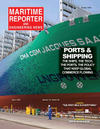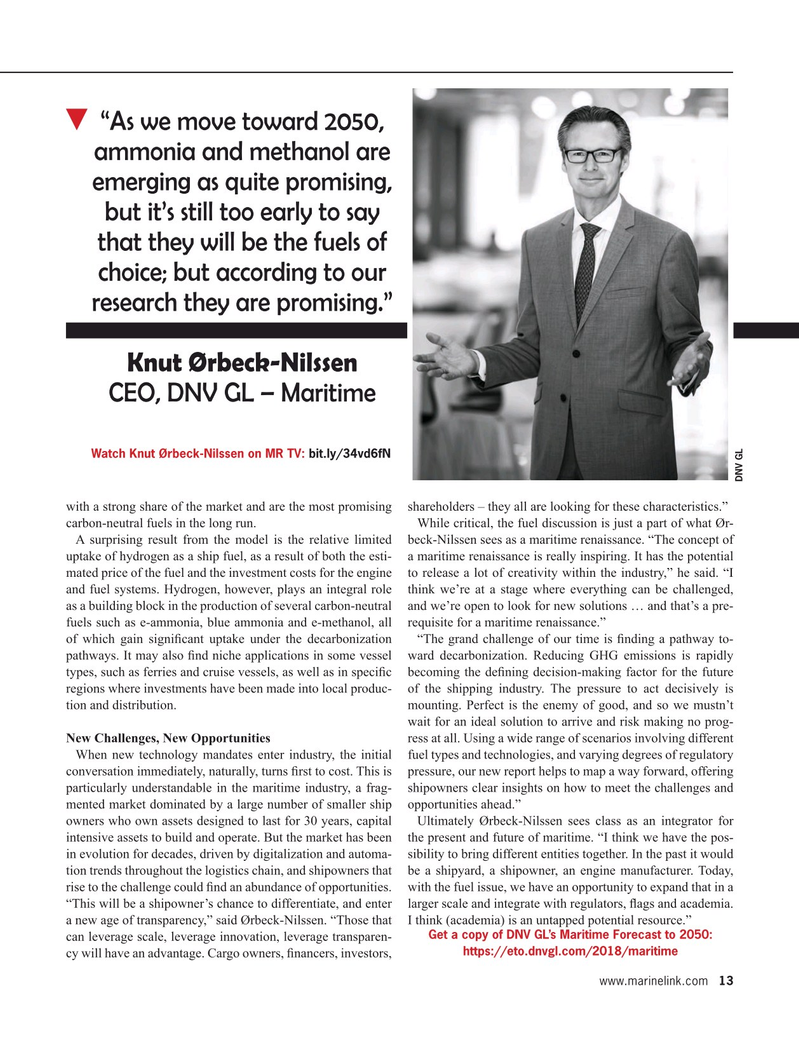
Page 13: of Maritime Reporter Magazine (October 2020)
Shipping & Port Annual
Read this page in Pdf, Flash or Html5 edition of October 2020 Maritime Reporter Magazine
“As we move toward 2050, ammonia and methanol are emerging as quite promising, but it’s still too early to say that they will be the fuels of choice; but according to our research they are promising.”
Knut Ørbeck-Nilssen
CEO, DNV GL – Maritime
Watch Knut Ørbeck-Nilssen on MR TV: bit.ly/34vd6fN
DNV GL with a strong share of the market and are the most promising shareholders – they all are looking for these characteristics.” carbon-neutral fuels in the long run. While critical, the fuel discussion is just a part of what Ør-
A surprising result from the model is the relative limited beck-Nilssen sees as a maritime renaissance. “The concept of uptake of hydrogen as a ship fuel, as a result of both the esti- a maritime renaissance is really inspiring. It has the potential mated price of the fuel and the investment costs for the engine to release a lot of creativity within the industry,” he said. “I and fuel systems. Hydrogen, however, plays an integral role think we’re at a stage where everything can be challenged, as a building block in the production of several carbon-neutral and we’re open to look for new solutions … and that’s a pre- fuels such as e-ammonia, blue ammonia and e-methanol, all requisite for a maritime renaissance.” of which gain signi? cant uptake under the decarbonization “The grand challenge of our time is ? nding a pathway to- pathways. It may also ? nd niche applications in some vessel ward decarbonization. Reducing GHG emissions is rapidly types, such as ferries and cruise vessels, as well as in speci? c becoming the de? ning decision-making factor for the future regions where investments have been made into local produc- of the shipping industry. The pressure to act decisively is tion and distribution. mounting. Perfect is the enemy of good, and so we mustn’t wait for an ideal solution to arrive and risk making no prog-
New Challenges, New Opportunities ress at all. Using a wide range of scenarios involving different
When new technology mandates enter industry, the initial fuel types and technologies, and varying degrees of regulatory conversation immediately, naturally, turns ? rst to cost. This is pressure, our new report helps to map a way forward, offering particularly understandable in the maritime industry, a frag- shipowners clear insights on how to meet the challenges and mented market dominated by a large number of smaller ship opportunities ahead.” owners who own assets designed to last for 30 years, capital Ultimately Ørbeck-Nilssen sees class as an integrator for intensive assets to build and operate. But the market has been the present and future of maritime. “I think we have the pos- in evolution for decades, driven by digitalization and automa- sibility to bring different entities together. In the past it would tion trends throughout the logistics chain, and shipowners that be a shipyard, a shipowner, an engine manufacturer. Today, rise to the challenge could ? nd an abundance of opportunities. with the fuel issue, we have an opportunity to expand that in a “This will be a shipowner’s chance to differentiate, and enter larger scale and integrate with regulators, ? ags and academia. a new age of transparency,” said Ørbeck-Nilssen. “Those that I think (academia) is an untapped potential resource.”
Get a copy of DNV GL’s Maritime Forecast to 2050: can leverage scale, leverage innovation, leverage transparen- https://eto.dnvgl.com/2018/maritime cy will have an advantage. Cargo owners, ? nancers, investors, www.marinelink.com 13
MR #10 (1-17).indd 13 10/6/2020 8:36:49 AM

 12
12

 14
14
